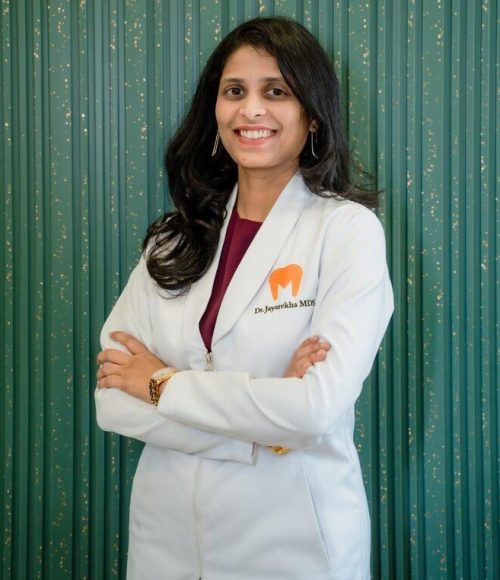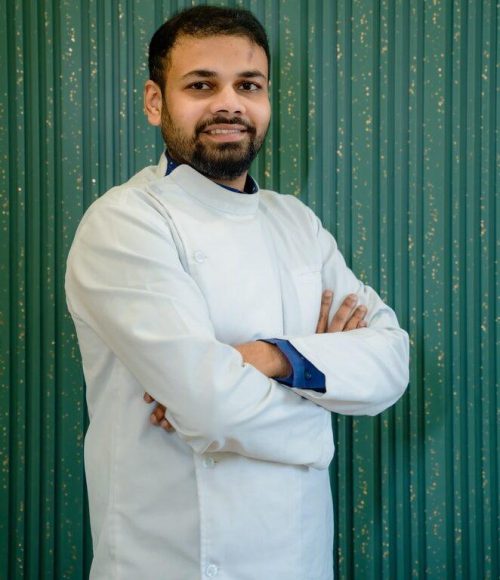Crown and Bridge
Crowns and bridges are fixed artificial teeth that deal with the restoration of damaged teeth. Unlike removable devices such as dentures, which can be taken out and cleaned daily, these are cemented onto existing teeth and can only be removed by a dentist.
Crown
Also called as a dental cap, it completely encircles a tooth.
Crowns are usually indicated
- In cases of large restorations,
- To strengthen non-vital teeth after a root canal treatment and
- To protect the structure of a tooth that is fractured or broken.
- Besides strengthening a damaged tooth, a crown can be used for cosmetic or functional reasons to improve its appearance, shape or alignment.
Crowns can be made of Porcelain fused to metal or all-ceramic to match the color of natural teeth or of other materials like gold, metal alloys and acrylic.
Bridges
Unlike crowns which are single units, a bridge is made up of 2 or more units. It may be recommended:
- if one or more teeth are missing
- where implants cannot be done
- where cost is a consideration
Bridges are cemented to the natural teeth on either side of the missing tooth. As with crowns, there is a choice of materials for bridges. Your dentist can help you decide which to use, based on the location of the missing tooth (or teeth), its function, aesthetic considerations and cost. Porcelain or ceramic bridges can be matched to the color of your natural teeth.
We offer metal ceramic and metal free (all ceramic) crown and bridge works keeping up with the latest trend in esthetics. We practice cad/ cam dentistry.
Types of Crown and bridge available:
- All metal
- Metal ceramic
- Metal free / all ceramic
Metal Free Crown
Zirconia Crowns
Thanks to its extreme durability and natural look, zirconia crown is getting more and more popular.
Advantages of Having Zirconium Crown
Zirconium is becoming one of the most chosen materials for dental crowns. Its many advantages include:
- Extraordinarily tough
- Can withstand wear and tear
- Translucent enough to be similar to natural teeth
- Less tooth removal
- No Metal fuse
- Modifiable size, shape and color
- Biocompatible
The aesthetic effects alone of a zirconia crown should be the biggest advantage it can give. It is important that you have dental crowns that will look natural especially if it will be placed at the front teeth and will be visible beside the natural teeth.
Zirconium crown will not only replace a tooth but it can be shaped so that it will look better than the one it will be replacing. This is why you can spot that perfect natural looking smile anytime.
Dentures
Dentures are custom-made replacements for missing teeth and can be taken out and put back into your mouth. While dentures take some time getting used to, and will never feel exactly the same as natural teeth, today’s dentures are natural looking and more comfortable than ever.
Replacing missing teeth will help to improve your appearance and smile. Without support from the denture, facial muscles sag, making a person look older. Dentures can help you eat and speak more comfortably. There are two main types of dentures: Full and Partial.
Flexible Denture
Flexible partial dentures such as those made by custom-fabricated in a dental laboratory. They are prescription-only products that are placed by a licensed dentist after an impression of your mouth has been taken. Most flexible partial dentures involve very simple preparation because your natural teeth don’t need to be altered in any way. Flexible partials can be virtually invisible because there are no telltale metal clasps to cover your natural teeth. Furthermore, most flexible materials blend with the tissue in your mouth so that the only thing that shows is your beautiful smile.
BENEFITS
- High bio-compatibility
- Improved comfort
- Aesthetics
- Reduced chair time
When considering a removable partial, many people find the Flexible Partial to be the most comfortable option. The results of the flexible partial are beautiful, and patient satisfaction is very high. The fabrication process is non-invasive, and gives you confidence in your restoration while talking, eating and most importantly, smiling!
How to Care for Your Flexible Partial Denture?
Like your own natural teeth, flexible partial dentures require care and good oral hygiene. To keep your restoration looking and feeling like new, please follow these simple flexible partial denture care directions:
– Clean your appliance regularly. Most brands of flexible partials will have a specific cleaner that is recommended for regular soaking of your new denture. Please consult your dentist if you have any questions regarding the type of denture cleaner you should be using.
– Loose particles can be removed with the use of a sonic denture cleaner, or by placing the appliance under running water. Brushing a denture is generally not recommended as this may remove the polish and roughen the surface over time.
– If possible, rinse your new dental appliance after eating to remove any food particles.
– Keep the partial in water or in denture cleaner whenever it is not being worn to keep the surface hydrated.
– Remember to brush your natural teeth and gums regularly as directed by your dentist.
Complete Dentures
A Complete Denture is a removable prosthesis that replaces all teeth within an arch, thus some patients have only an upper denture, some only a lower and some have both upper and lower complete dentures.
Advantages of Complete Dentures
- Least costly treatment for replacing all teeth in an entire arch
- Esthetically pleasing
- Shortest treatment time from start to finish
Disadvantages of Complete Dentures
- They can feel very bulky, particularly upper dentures which cover the entire roof of the mouth
- Lower dentures are rarely as stable as upper dentures because of various muscles, including the tongue, which all shift and dislodge the denture
- Not all mouths are created equal when it comes to denture retention . . . thus, no matter how good a denture is made, some patients will never be able to have a comfortable and stable denture due to the anatomy of their jaws. Other options exist to help such patients obtain stable dentures.
- A patient’s jaw changes over time and dentures have to be relined occasionally to remain stable.
Why should we wear complete dentures?
Replacing missing teeth enhances your oral, general health and your appearance. Dentures also improve a person’s ability to speak and to eat.
How Are Dentures Made?
The denture development process takes 6-7 appointments. Once your prosthodontist determines what type of appliance best suits you, the general steps are to:
- Making of preliminary impression of your jaw and take measurements of how your jaws relate to one another and how much space is between them.
- Fabrication of models, wax patterns, and/or plastic patterns in the exact shape and position of the denture will be made. You will “try in” this model and the denture will be assessed for colour, shape, and fit before the final denture is cured.
- Cast a final denture
- Adjustments will be made as necessary.
- Recall and assessment of denture
Types of dentures
Conventional and immediate
- BPS dentures
- Over dentures
BPS Dentures
What does BPS mean?
Biofunctional : The most important demand on your denture is to reproduce the functions of the natural teeth during mastication and speaking to a very high extent.
Prosthetic : BPS promotes the fabrication of quality dentures. Only certified dental technicians are authorized to fabricate BPS dentures after thorough analysis of your individual situation.
System : BPS dentures are fabricated of especially coordinated materials. The excellent cooperation between the dentist and the BPS certified dental technician enables the optimum analysis of your personal data and their use for the fabrication of distinctive BPS dentures.
BPS, the biofunctional prosthetic system, has been especially developed to match the requirements of the patients.
What is the difference between BPS dentures and conventional dentures?
With BPS, IvoclarVivadent has succeeded in combining 80 years of corporate experience with the latest scientific knowledge.
For your benefit!
The difference can already be perceived during the first dentist appointment:
If required, individualization of your BPS dentures is also possible. This means, for example, that the tooth shade or optical structure of your natural teeth are reproduced in your dentures. In this way, your dentures are not just white and regular, but demonstrate a true-to-nature and individual appearance.
The aesthetic appearance of your dentures will be designed especially for you with the help of comprehensive shade analyses. By means of various impressions of your jaw it is possible to pass on a maximum of information to the dental technician.
OVER DENTURES
Overdentures are replacement of your teeth which rest either on natural teeth or dental implants. The drawback with conventional dentures is that the first denture was usually satisfactory but with each passing year & with each subsequent denture, patients become more intolerant of their prosthesis. The resorption of bone began a vicious cycle of an ill-fitting denture, causing inflammation, which in turn increases the resorptive process, creating an even more unstable base, repeating the entire process once again.
- With overdenture you will have more control over your dentures they by fewer complications.
- More support 2. Withstands more occlusal load 3. Retention improve
- Alveolar bone exists as a support for teeth
- An increase in the patients manipulative skills in handling the denture
Make Appointment
Experienced Doctors
Meet Our Expert Dental Team
Testimonials
What Our Patients Say About Us

Posted onTrustindex verifies that the original source of the review is Google. Dr. Mohan is very friendly and supportive during the treatment, i’m happy and satisfied the way he treated my kid. Thank you for your suggestions and guidance😀I strongly recommend this clinic for dental treatment!!!Posted onTrustindex verifies that the original source of the review is Google. Every doctor treats the problem but taking care of very minor issues and suggesting the best is glad for usPosted onTrustindex verifies that the original source of the review is Google. Overall Treatment and experience is good, Feeling good after I had my crowns. It gives new look to me. The staff will give good guidance or any suggestions for better understanding.Posted onTrustindex verifies that the original source of the review is Google. Planning to have a smile designing from a long time, finally had it. Thanks to Dr Mohan for making it happen. Highly recommended .Posted onTrustindex verifies that the original source of the review is Google. My teeth alignment went so good with less pain doctor took atmost care while treating me staff also great Thankyou dr mohanPosted onTrustindex verifies that the original source of the review is Google. Treated by Dr Rekha. Painless procedure and very good ambience along with the best care.Load more
How It Works
Your Journey to a Healthy Smile Starts Here

Make Appointment
Book an appointment by filling the appointment form on our website

Visit Our Clinic
Visit our clinic on your scheduled time to consult one of our dental specialist

Follow Up
We will be in touch with you regarding your upcoming sittings and treatments


